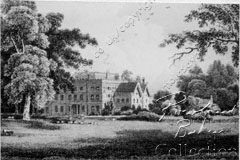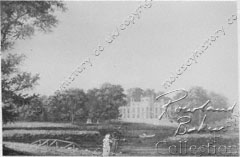| Boyle Farm - Mrs. Charlotte Boyle Walsingham |
After the departure of the earl of Hertford a new tenant was found. With whom the situation closely resembled that which had pertained twenty-five years earlier when Mrs. Digby had arrived. As then, the lessee was an affluent aristocratic widow. As then, the lady's name was Charlotte. As then, she was merited with the title "honourable". As then, after a short time in the tenancy she, too, persuaded the owner to allow her to purchase the freehold of the house.
This lady's name was Mrs. Charlotte Boyle Walsingham, the daughter of Sir Charles Hanbury Williams (1708-1759), author, member of Parliament, and diplomat. He represented this country in both Germany and Russia(105).
From her father she inherited a love of literature and of art. Williams wrote to her from St. Petersburg, advising her: "Whenever you read any poetry you like, be sure to get the finest passages by heart. But you must read with care, or you had better not read it at all. For it is with reading, as with eating. It is not the quantity of what we eat or read, but what we digest, that does good" (106).
Her relationship with her mother was sometimes less cordial. When she was just fourteen, for instance, and of poor health, she suffered a severe illness brought about by a harsh beating her mother had given her simply for reading Fielding's novel, Tom Jones. Which provoked Henry Fox, first Lord Holland (the brother of Mrs. Charlotte Digby, the former owner of Fords) to report the matter to her father, and urged him to take the girl away from her mother and educate her himself on the Continent: "To whip a girl of fourteen for anything is wrong and indecent: for what they called her fault, ill-natur'd and unjust: in her circumstances of health and constitution, creul and inhuman"(107).
No wonder as soon as she could she tried to get herself married. When only eighteen years old she threw herself at the impecunious son of the earl of Buckinghamshire. Which, when reported to her father, brought him scurrying back from Russia to prohibit the wedding, unless the young hopeful could produce evidence of having £1,000 a year to support her. Which he could not do. Her mother at first offered the couple a sum of money, but later forbade them to meet. Charlotte, however, was self-willed and although overtly manifested complete capitulation to her parents' desire, covertly carried on a romantic correspondence with her lover. When Sir Charles found out his fury waxed fervent. Charlotte finally succumbed to her filial duty and the affair was brought to an end. The young nobleman, a few months later, married another lady, and eventually succeeded to his father's title and fortune(108).
Sir Charles, obviously feeling that he would suffer no peace until his daughter was safely settled in the wedded state, looked around for what he considered an ideal match. Sometime later he announced to the world that she was affianced to a new suitor, and that she liked him very much. Nevertheless, this seems to have been rather an exaggeration, for apparently she hardly knew the chosen one at all, even by sight. Charlotte was not the girl to have a husband foisted upon her, even by her own father, and the marriage never took place(109).
During the latter years of his life Sir Charles Williams suffered from an extremely painful illness, and eventually died by his own hand in November 1759. He left the whole of his estate in trust for his two daughters, but his malady had deteriorated so far that he was totally unaware of what was going on around him, that his elder daughter had died, and what is more that Charlotte had at last been married. She was now his sole heiress, and a very rich woman(110).
The husband of her choice was the Hon. Robert Boyle Walsingham, son of the earl of Shannon, who was two years her senior. He was then a captain in the navy, and had been a member of Parliament for two years(111). He had been born just Robert Boyle, but had assumed the additional surname on inheriting a share of an estate which had formerly belonged to a kinswoman, Lady Osborn, whose maiden name had been Walsingham(112).
Soon after the marriage the couple were granted the use of a suite of rooms on the south side of Clock Court in Hampton Court Palace(113), and afterwards transferred to a similar apartment at Windsor.
In 1780 Boyle Walsingham, now a commodore, was placed in charge of a squadron on its way to reinforce a fleet commanded by Admiral Rodney in the West Indies. Flying his flag in the "Thunderer", a man of war with 74 guns and a crew of six hundred men. In October, just off Jamaica, they sailed into a most violent hurricane, and the ship went down with all hands(114).
Mrs. Boyle Walsingham, now a rich widow, sought a house where she could live in suitable style with her two children. Whilst occupying the rooms at Hampton Court she undoubtedly would have looked across the Thames to Fords, and may well have visited Mrs. Digby there. The Williams, Fox, and Digby families were all very close. Sir Charles Williams, when he was in Germany, had procured for Mrs. Digby a fine set of dinner ware from the famous Dresden china factory(115), which probably often graced the table at Fords.
Now that Lord Hertford had given up the tenancy the opportunity arose for her to take the house over. Its delightful ambience, the perfect setting, the views across the river to the magnifcent avenues of Hampton Court Park, would all have appealed to Mrs. Boyle Walsingham's strong artistic emotions.
Her children were: a daughter, like herself named Charlotte, of whom we shall have a great deal to say later; and a son, Richard, who became a lieutenant in the Guards. A very personable youth, he was described by the prince of Wales, later George the fourth, who was his contemporary, as having "more wit and talents, and as much good sense and good nature" as any man he had ever known(116). Walpole told one of his friends: "He is a very pleasing young man; a fine figure, his face like hers(his mother's), with something of his grandfather Sir Charles Williams, without his vanity; very sensible, and uncommonly well bred"(117). Mary Hamilton, the novelist, echoed this with: "a handsome, lively, well-bred & I beleive sensible young man". But then rather spoils it by going on:
"I have heard that he is dissipated & extravagant, but how few, how very few young men are otherwise"(118). (What a modern ring this last sentence has!).
Dissipated he must have been, and it soon began to take its toll. In 1785, when he was but twenty-five, his mother was writing to Mrs. Delany: "Alas my time and thoughts have all been devoted to endeavours for the recovery of my son's health, on whose fine person and constitution 'fell dissipation has already done the work of time'. He has in my opinion, every sympton of a consumption, spitting blood, night sweats, &c."(119).
 |
 |
Boyle Farm as originally built from the south-east |
from across the river |
After a short time, however, a schism appeared between mother and son, both were so alike - heady and self-willed - and she disowned him. Hannah More wrote to Walpole: "I grieve for the poor sick son of our too rigorous and inexorable friend. O why will she harden herself to the two most irresistible of all claims, a child, and sick!"(120). He lingered in this state for another three years and died at Bristol in October 1788(121). According to the prince of Wales:"If he had not died early (he) would have been one of the most considerable men that England had ever produced" (116).
In March 1783, after having lived in the house for a year, and having decided she liked it, Mrs. Boyle Walsingham persuaded Stephen Digby to sell her the freehold of the estate.
In the deed of transfer it was described as: "the Capital Mansion called Fords, with pleasure grounds, orchards, garden, field, lawns, shrubberies, greenhouse, farmyards, barns, stables, etc. and Boathouse Close, and various parcels of land" (122). Included in the purchase were the islands in the river, and several other pieces of land in Thames Ditton and East Molesey which were copyhold of the manor of Molesey Prior(123).
Stephen Digby retained a number of other properties in Thames Ditton, which, in 1785 he transferred to his elder brother, Thomas, dean of Durham(124). He died in 1800, and was buried in Thames Ditton churchyard by the side of his beloved first wife(125).
All books copyright © R G M Baker, all rights reserved.
Images © 2006 M J Baker and S A Baker, all rights reserved.
Web page design © 2006 M J Baker and S A Baker, all rights reserved.